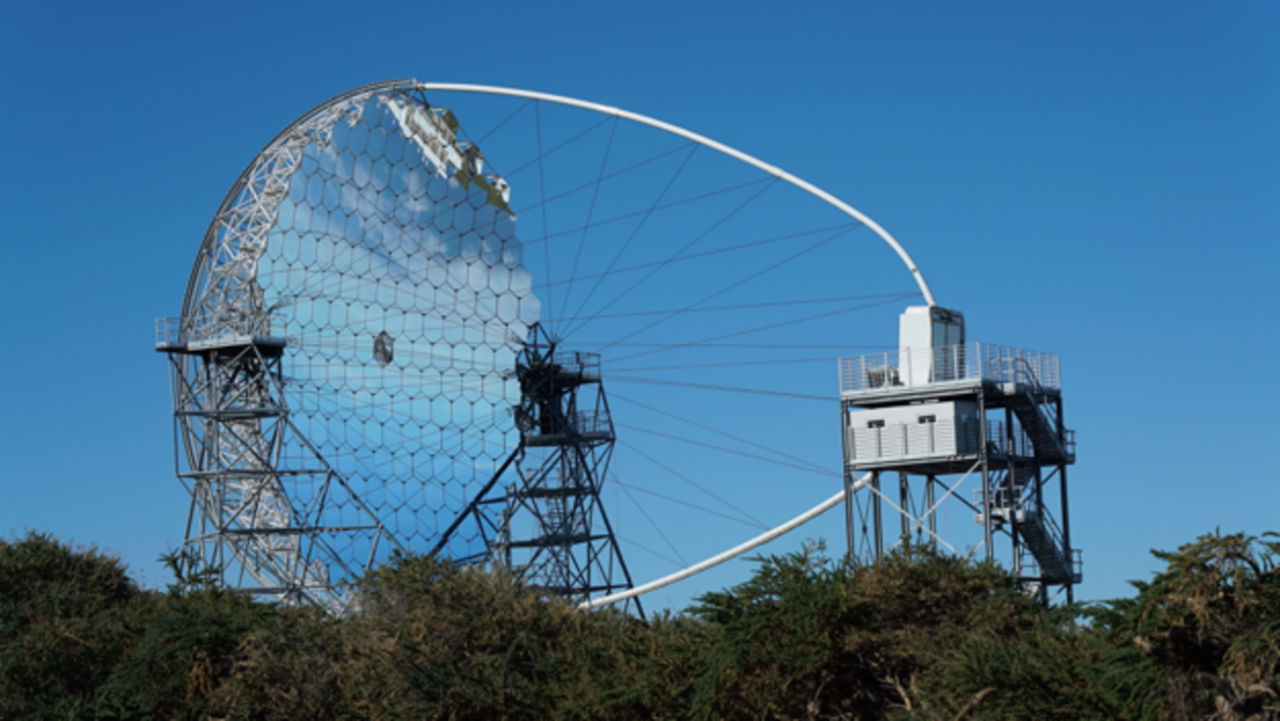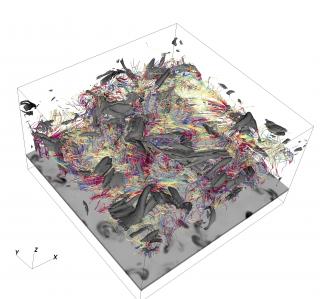Grants related:
General
The MAGIC Collaboration is integrated by 20 research institutes and university departments from Armenia, Bulgaria, Finland, Germany, Italy, Poland, Spain, Switzerland and USA. The collaboration comprises two 17m diameter telescopes, located at the Roque de los Muchachos Observatory, designed to measure the Cherenkov radiation associated with atmospheric showers from very high-energy gamma rays.
CTA is a major international collaboration for building two large Cherenkov observatories at North and South Hemispheres. Roque de los Muchachos Observatory in La Palma has been selected to host the Northern observatory. The first large size telescope was inaugurated in October 2018, and we are presently building the other three.
Members
Results
- Inauguration of the first large-size telescope of CTA (LST-1) at the Observatorio del Roque de Los Muchachos
- Detection of a neutrino generated in a blazar with MAGIC, IcCube and Fermi-LAT
- Discovery of the binary systemPSR J2032+4127/MT91 213 emitting in VHE gamma rays.
Scientific activity
Related publications
-
Statistical redshift of the very-high-energy blazar S5 0716+714
Context. Blazars are the most numerous class of very-high-energy (VHE; E > 100 GeV) gamma-ray emitters. At present, measured redshifts are available only for about 80% of the VHE gamma-ray sources; this is mainly due to the difficulty in measuring reliable redshifts from their nearly featureless continuum optical spectra. Aims: As the VHE sky is
Pichel, A. et al.Advertised on:
122023 -
Performance of the joint LST-1 and MAGIC observations evaluated with Crab Nebula data
Aims: Large-Sized Telescope 1 (LST-1), the prototype for the Large-Sized Telescope at the upcoming Cherenkov Telescope Array Observatory, is concluding its commissioning phase at the Observatorio del Roque de los Muchachos on the island of La Palma. The proximity of LST-1 to the two MAGIC (Major Atmospheric Gamma Imaging Cherenkov) telescopes makes
Abe, H. et al.Advertised on:
122023 -
Detection of a Peculiar Drift in the Nuclear Radio Jet of the TeV Blazar Markarian 501
Mrk 501 is one of the most prominent TeV-emitting blazars and belongs to the class of high synchrotron peaked (HSP) blazars. The Doppler factors derived from the jet kinematics are much too low to provide sufficient beaming for the detected high-energy emission (the so-called Lorentz factor crisis). This BL Lac object is also a prime example of a
Britzen, Silke et al.Advertised on:
22023 -
The Third Fermi Large Area Telescope Catalog of Gamma-Ray Pulsars
We present 294 pulsars found in GeV data from the Large Area Telescope (LAT) on the Fermi Gamma-ray Space Telescope. Another 33 millisecond pulsars (MSPs) discovered in deep radio searches of LAT sources will likely reveal pulsations once phase-connected rotation ephemerides are achieved. A further dozen optical and/or X-ray binary systems
Smith, D. A. et al.Advertised on:
122023 -
Star tracking for pointing determination of Imaging Atmospheric Cherenkov Telescopes. Application to the Large-Sized Telescope of the Cherenkov Telescope Array
We present a novel approach to the determination of the pointing of Imaging Atmospheric Cherenkov Telescopes (IACTs) using the trajectories of the stars in their camera's field of view. The method starts with the reconstruction of the star positions from the Cherenkov camera data, taking into account the point spread function of the telescope, to
Abe, K. et al.Advertised on:
112023 -
Temporal Structures in Positron Spectra and Charge-Sign Effects in Galactic Cosmic Rays
We present the precision measurements of 11 years of daily cosmic positron fluxes in the rigidity range from 1.00 to 41.9 GV based on 3.4 ×10 6 positrons collected with the Alpha Magnetic Spectrometer (AMS) aboard the International Space Station. The positron fluxes show distinctly different time variations from the electron fluxes at short and
Aguilar, M. et al.Advertised on:
102023 -
Observations of the Crab Nebula and Pulsar with the Large-sized Telescope Prototype of the Cherenkov Telescope Array
The Cherenkov Telescope Array (CTA) is a next-generation ground-based observatory for gamma-ray astronomy at very high energies. The Large-Sized Telescope prototype (LST-1) is located at the CTA-North site, on the Canary Island of La Palma. LSTs are designed to provide optimal performance in the lowest part of the energy range covered by CTA, down
Abe, H. et al.Advertised on:
102023 -
A Reemerging Bright Soft X-Ray State of the Changing-look Active Galactic Nucleus 1ES 1927+654: A Multiwavelength View
1ES1927+654 is a nearby active galactic nucleus (AGN) that has shown an enigmatic outburst in optical/UV followed by X-rays, exhibiting strange variability patterns at timescales of months to years. Here we report the unusual X-ray, UV, and radio variability of the source in its postflare state (2022 January-2023 May). First, we detect an increase
Ghosh, Ritesh et al.Advertised on:
92023 -
Fermi-GBM Discovery of GRB 221009A: An Extraordinarily Bright GRB from Onset to Afterglow
We report the discovery of GRB 221009A, the highest flux gamma-ray burst (GRB) ever observed by the Fermi Gamma-ray Burst Monitor (Fermi-GBM). This GRB has continuous prompt emission lasting more than 600 s, which smoothly transitions to afterglow emission visible in the Fermi-GBM energy range (8 keV-40 MeV), and total energetics higher than any
Lesage, S. et al.Advertised on:
82023 -
Sensitivity of the Cherenkov Telescope Array to TeV photon emission from the Large Magellanic Cloud
A deep survey of the Large Magellanic Cloud at ~0.1-100 TeV photon energies with the Cherenkov Telescope Array is planned. We assess the detection prospects based on a model for the emission of the galaxy, comprising the four known TeV emitters, mock populations of sources, and interstellar emission on galactic scales. We also assess the
Acharyya, A. et al.Advertised on:
82023 -
Variability and evolution of the optical polarization of a sample of gamma-ray blazars
We present a polarization variability analysis of a sample of 26 γ-ray blazars monitored by the Steward Observatory between 2008 and 2018 in the optical band. We investigate the properties and long-term variability of their optical polarization, searching for differences between blazar types. We observe that BL Lac objects are typically less
Otero-Santos, J. et al.Advertised on:
82023 -
Multimessenger Characterization of Markarian 501 during Historically Low X-Ray and γ-Ray Activity
We study the broadband emission of Mrk 501 using multiwavelength observations from 2017 to 2020 performed with a multitude of instruments, involving, among others, MAGIC, Fermi's Large Area Telescope (LAT), NuSTAR, Swift, GASP-WEBT, and the Owens Valley Radio Observatory. Mrk 501 showed an extremely low broadband activity, which may help to unravel
Abe, H. et al.Advertised on:
62023 -
Properties of Cosmic-Ray Sulfur and Determination of the Composition of Primary Cosmic-Ray Carbon, Neon, Magnesium, and Sulfur: Ten-Year Results from the Alpha Magnetic Spectrometer
We report the properties of primary cosmic-ray sulfur (S) in the rigidity range 2.15 GV to 3.0 TV based on 0.38 ×10 6 sulfur nuclei collected by the Alpha Magnetic Spectrometer experiment (AMS). We observed that above 90 GV the rigidity dependence of the S flux is identical to the rigidity dependence of Ne-Mg-Si fluxes, which is different from the
Aguilar, M. et al.Advertised on:
52023 -
Multiwavelength study of the galactic PeVatron candidate LHAASO J2108+5157
Context. Several new ultrahigh-energy (UHE) γ-ray sources have recently been discovered by the Large High Altitude Air Shower Observatory (LHAASO) collaboration. These represent a step forward in the search for the so-called Galactic PeVatrons, the enigmatic sources of the Galactic cosmic rays up to PeV energies. However, it has been shown that
Abe, S. et al.Advertised on:
52023 -
Temporal Structures in Electron Spectra and Charge Sign Effects in Galactic Cosmic Rays
We present the precision measurements of 11 years of daily cosmic electron fluxes in the rigidity interval from 1.00 to 41.9 GV based on 2.0 ×10 8 electrons collected with the Alpha Magnetic Spectrometer (AMS) aboard the International Space Station. The electron fluxes exhibit variations on multiple timescales. Recurrent electron flux variations
Aguilar, M. et al.Advertised on:
42023 -
Sensitivity of the Cherenkov Telescope Array to spectral signatures of hadronic PeVatrons with application to Galactic Supernova Remnants
The local Cosmic Ray (CR) energy spectrum exhibits a spectral softening at energies around 3 PeV. Sources which are capable of accelerating hadrons to such energies are called hadronic PeVatrons. However, hadronic PeVatrons have not yet been firmly identified within the Galaxy. Several source classes, including Galactic Supernova Remnants (SNRs)
Acero, F. et al.Advertised on:
82023 -
Follow-up Survey for the Binary Black Hole Merger GW200224_222234 Using Subaru/HSC and GTC/OSIRIS
The LIGO/Virgo detected a gravitational wave (GW) event, named GW200224_222234 (also known as S200224ca) and classified as a binary-black hole coalescence, on 2020 February 24. Given its relatively small localization skymap (71 deg 2 for a 90% credible region; revised to 50 deg 2 in GWTC-3), we performed target-of-opportunity observations using the
Ohgami, Takayuki et al.Advertised on:
42023 -
The Fermi-LAT Lightcurve Repository
The Fermi Large Area Telescope (LAT) lightcurve repository (LCR) is a publicly available, continually updated library of gamma-ray lightcurves of variable Fermi-LAT sources generated over multiple timescales. The Fermi-LAT LCR aims to provide publication-quality lightcurves binned on timescales of 3, 7, and 30 days for 1525 sources deemed variable
Abdollahi, S. et al.Advertised on:
42023 -
MAGIC observations provide compelling evidence of hadronic multi-TeV emission from the putative PeVatron SNR G106.3+2.7
Context. Certain types of supernova remnants (SNRs) in our Galaxy are assumed to be PeVatrons, capable of accelerating cosmic rays (CRs) to ~ PeV energies. However, conclusive observational evidence for this has not yet been found. The SNR G106.3+2.7, detected at 1-100 TeV energies by different γ-ray facilities, is one of the most promising
MAGIC Collaboration et al.Advertised on:
32023 -
A lower bound on intergalactic magnetic fields from time variability of 1ES 0229+200 from MAGIC and Fermi/LAT observations
Context. Extended and delayed emission around distant TeV sources induced by the effects of propagation of γ ray s through the intergalactic medium can be used for the measurement of the intergalactic magnetic field (IGMF). Aims: We search for delayed GeV emission from the hard-spectrum TeV γ-ray emitting blazar 1ES 0229+200, with the goal of
Acciari, V. A. et al.Advertised on:
22023
Related talks
No related talks were found.Related conferences
No related conferences were found.News
-
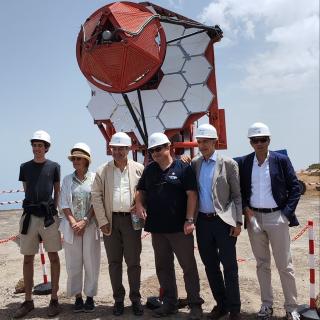 ASTRI telescopes at the Teide Observatory: an example of environmental integrationAdvertised on
ASTRI telescopes at the Teide Observatory: an example of environmental integrationAdvertised on -
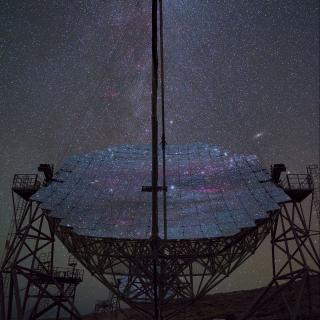 MAGIC Telescope System detects energetic nuclear blast from vampire starAdvertised on
MAGIC Telescope System detects energetic nuclear blast from vampire starAdvertised on -
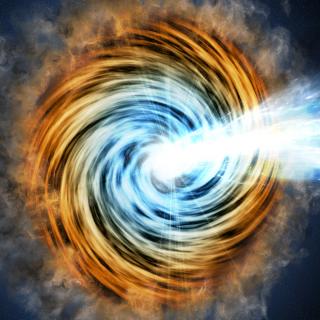 The Gran Telescopio Canarias finds the farthest black hole that belongs to a rare family of galaxiesAdvertised on
The Gran Telescopio Canarias finds the farthest black hole that belongs to a rare family of galaxiesAdvertised on
